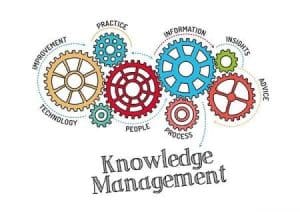Generally, in organizations, development work encompasses a varied network of persons and also teams working toward common aims. Groups that are most effective in fulfilling these objectives have systems in place with which they consistently communicate vital knowledge. Hence they obtain fast access to the most recent research and integrate lessons learned into better programs. Furthermore, knowledge management may increase coordination and enhance meaningful learning, collaboration, and also application. So, this article will be a guide for organizing the knowledge management process, the various types, and also some examples of how this knowledge management works. Also, we’ll be looking at some tools we can use for effective knowledge management.
What is Knowledge Management?
Knowledge management (KM) is the process of locating, organizing, storing, and sharing information inside an organization. When knowledge is not easily available within an organization, it may be extremely costly to a firm since they waste valuable time seeking out relevant information rather than accomplishing tasks.
A knowledge management system (KMS) harnesses an organization’s pooled knowledge, resulting in increased operational efficiencies. The use of a knowledge base aids these systems. They are typically crucial to good knowledge management because they provide a centralized location to store information and easily access it.
Companies that implement a knowledge management strategy obtain better business outcomes sooner because enhanced organizational learning and collaboration among team members allow for speedier decision-making across the firm. It also streamlines other organizational processes, such as training and onboarding, resulting in improved employee satisfaction and retention. We have different types of knowledge management.
Types of Knowledge Management
There are three types of knowledge management, according to the definition: tacit, implicit, and explicit knowledge. The coding of information is what distinguishes these types of knowledge management.
Tacit knowledge is the knowledge that is acquired via experience and is instinctively grasped. As a result, it is difficult to express and codify, making it difficult to communicate this information to other people. Language, facial recognition, and leadership abilities are examples of tacit knowledge.
While some literature equates implicit knowledge with tacit knowledge, several academics distinguish this type, stating that the concept of strategy knowledge is more nuanced. While tacit knowledge is difficult to codify, implicit knowledge does not always have this issue. Instead, implicit knowledge has yet to be documented. It typically exists within processes and they often refer to it as “know-how” knowledge.
Explicit knowledge: Explicit knowledge is in numerous document types such as manuals, reports, and guidelines, allowing organizations to quickly exchange knowledge across teams. This type of knowledge is likely the most well-known, and examples include knowledge assets such as databases, white papers, and case studies. This type of knowledge is vital for retaining intellectual capital within a company as well as for successful knowledge transfer to new personnel.
Tools for Knowledge Management
Organizations can reap the benefits of knowledge management by utilizing a variety of tools. Examples of tools for knowledge management systems include:
#1. Document management systems
They serve as a centralized storage system for digital documents such as PDFs, pictures, and word processing files. These systems improve staff processes by allowing for the easy retrieval of documents such as lessons learned.
#2. Content management systems (CMS)
These are software that manages web material and allows end-users to update and publish content. CMSs are frequently confused with document management systems, but CMSs can also support other media types including audio and video.
#3. Intranets
These are private networks that operate entirely within an organization and allow for the sharing of enablement, tools, and processes among internal stakeholders. While they can be time-consuming and expensive to operate, they provide a variety of groupware functions, such as internal directories and search, that aid in cooperation.
#4. Wikis
Due to their ease of use, can be a popular knowledge management tool. They make it simple to post and amend the information, but this convenience might lead to worries about disinformation because workers may update them with false or obsolete information.
#5. Data warehouses
These consolidate data from several sources into a single, centralized, consistent data storage to facilitate data analysis, data mining, artificial intelligence (AI), and machine learning. Data is retrieved from these repositories so that businesses can get insights, empowering staff to make data-driven decisions.
Examples and Best Practices for Knowledge Management
Knowledge management will differ depending on the demands of the firm. The following are some of the most prevalent types of knowledge management examples:
#1. Tutoring and training, communities of practice, Q&A, and expertise location
All of these management examples involve the transfer of knowledge directly from the knowledge bearer.
This could be accomplished through in-person tutoring, company-wide training seminars, internet chats, and group discussions, or a combination of these and other approaches.
For expertise placement to be a successful part of a knowledge management system, a searchable matrix that allows for competency documentation must be created.
Pros:
- Questions can get answers immediately.
- If the material is unclear, clarifications can be made.
- Brainstorming sessions can be facilitated, utilizing the combined power of the group’s expertise and knowledge.
- In-person learning is more likely to be recalled clearly.
Cons:
- It can be time-consuming and distracting from the tasks that the knowledge holder is attempting to do.
- Building and maintaining an expertise location system can be time-consuming.
- It can be tough to document and save for future use.
- If the knowledge bearer leaves the company, you risk losing the knowledge.
#2. Documentation, instructions, guidelines, FAQs, and tutorials
These written exchanges are excellent for preserving and sharing knowledge. So, this text-based knowledge management example necessitates the use of a system for storing, categorizing, and navigating subjects. Hence, in many circumstances, metadata can be of considerable assistance.
Pros:
- Can be readily archived and kept
- It is simple to share information online.
- It is simple to aggregate the expertise of numerous people into a single packet.
- When solutions are neatly arranged, they may be reached quickly.
Cons:
- It takes more time to create
- If the knowledge does not have a good structure, it will be difficult to find.
- Knowledge must be kept up to date.
#3. Forums, intranets, and collaborative environments
These online tools encourage discussion and bring together a diverse range of knowledge holders. Threads, subforums, and groups can be classified by topic, level of experience, or any number of other criteria.
Pros:
- Collaboration fuels innovation.
- Many experts, no matter where they are in the world, can be brought together in one spot.
- Facilitating contact with remote workers promotes teamwork and knowledge sharing.
Cons:
- It can be a chaotic and noisy setting.
- Knowledge is not actively evaluated as it is introduced to discussions.
- It takes time to sift through several messages and threads for pertinent responses.
- Messages and threads may not be archived.
#4. Learning and development environments
Creating a workplace where they value learning will motivate employees to continue their education. Also, incentivizing them to use your knowledge management systems will result in upskilled individuals who are ready to take on leadership responsibilities in your firm.
Employees must be able to use structured and accessible learning and development technology for this to occur.
Pros:
- It motivates personnel can grow at their own pace.
- Also, training paths can be mapped out.
- Finally, one can find subjects more easily thanks to the structure.
Cons:
- It takes a lot of time and effort to construct and maintain.
- Content must be developed and also maintained on a regular basis.
#5. Case studies
These in-depth investigations into specific disciplines provide comprehensive guides to a subject.
Examining actions taken, the outcomes of those activities, and also the lessons gained can be incredibly beneficial, allowing lessons learned to be completely documented and archived.
Pros:
- It allow for complete documenting and also the archiving of lessons learned.
- Also, it is easily shareable
- It is also effective at communicating difficult information
Cons:
- It takes a lot of time and talent to make something.
- It may be too specific to apply the knowledge broadly.
#6. Webinars
These online lectures can be quite beneficial in disseminating ideas amongst teams, branches, or the entire firm.
Pros:
- Can be recorded and reused
- It is simple for all employees who are interested to attend.
Cons:
- Make the time and effort to plan, write, and also deliver.
- It is necessary to organize.
Knowledge Management Process
A company can use these four-step knowledge management processes to organize knowledge management. These are discovery, obtain, process, and share/benefits
#1. Discovery
How will knowledge be discovered within the organization?
There are numerous sources of knowledge in every company.
This step of the process identifies the sources of knowledge, as well as where critical knowledge is stored, what can be gained from this knowledge, and whether or not knowledge can be lost during the process.
A solid understanding of the organization’s knowledge flow aids the discovery process.
#2. Obtain
How will existing and new knowledge be stored?
Every company includes a large amount of knowledge, which must be carefully kept and also structured. Here knowledge is more easily retrieved, and the organizational structure is increased by building a mapped and then categorized system.
This can include document scanning, metadata use, and indexing.
#3. Process
How might this knowledge be best synthesized and integrated?
This stage entails a thorough examination of the knowledge obtained in the previous two processes. Hence, the organization must organize and analyze the knowledge to determine how best it can be incorporated into the organization’s structure.
This is the stage at which an organization should foster and promote a culture of knowledge sharing while also developing employees to be innovators.
How can employees within the company best gain access to this knowledge?
The goal of knowledge management is to make it easier for employees to access knowledge within the firm. The first stage is to create a functional system, but individuals must understand how to use that system. Also, implementing training programs can aid in the comprehension of knowledge management systems.
So, after using the system, the organization gains enhanced productivity, better decision-making, and also a more innovative staff.
How do you encourage employees to contribute to a Knowledge Management system?
Encouraging employees to contribute to a Knowledge Management system can be done by recognizing and rewarding contributors, making the process of contributing easy and accessible, and making it a part of their daily work routine.
How do you ensure that information in a Knowledge Management system remains up-to-date?
Ensuring that information in a Knowledge Management system remains up-to-date can be done by regularly reviewing and updating information, and encouraging employees to provide feedback and make updates.
What is the role of culture in Knowledge Management?
Culture plays a critical role in Knowledge Management by influencing how information is shared and used within an organization.
How do you balance the need for centralizing information with the need for decentralized decision-making?
Balancing the need for centralizing information with the need for decentralized decision-making can be done by implementing a flexible Knowledge Management system that allows for both centralized information storage and decentralized access.
What are some challenges in maintaining a Knowledge Management system?
Some challenges in maintaining a Knowledge Management system include ensuring the accuracy of information, encouraging user adoption, and staying up-to-date with new technologies.
How do you foster a culture of continuous learning within an organization?
Fostering a culture of continuous learning within an organization can be done by providing opportunities for employee training and development, encouraging employees to share knowledge, and recognizing and rewarding individuals who engage in continuous learning.
Conclusion
One of the most difficult challenges in deploying a knowledge management system is persuading people to accept it. So, they may be concerned that implementing a new system will consume too much of their time, or that sharing their knowledge will diminish the value they bring and jeopardize their jobs. Or they may simply be hesitant to incorporate yet another new tool or process into their operations.
As a result, it’s critical to have a strategy for not only storing and sharing knowledge within the organization but also encouraging colleagues to do the same. To be successful, you should aim to foster a workplace culture that values knowledge sharing. It also doesn’t hurt to have a knowledge management system process that is simple to use and integrates with your employees’ existing workflows.
Moreover, a knowledge management tool’s purpose should not only be to create favorable business outcomes. It should also have a good impact on your personnel. When your staff grasps the benefits, your chances of effectively implementing a knowledge management process increase dramatically.
Knowledge Management FAQs
What is knowledge management and why is it important?
Knowledge management is the process of capturing, storing, sharing, and effectively managing the knowledge and experience of employees to increase the workforce’s overall knowledge. Its primary goal is to improve efficiency, productivity and retain critical information within the company. (lowpricebud.co)
What is knowledge management and why is it important?
Knowledge management (KM) is the interdisciplinary process of creating, using, sharing, and maintaining an organization’s information and knowledge.
e benefits of proper Knowledge Management for your business
- Improve the decision-making process. …
- Increase customer satisfaction. …
- Promote innovation and cultural change. …
- Speed up access to knowledge and information. …
- Avoid redundant effort. …
- Accelerate customer delivery. …
- Stimulate growth and innovation
How Do You Develop a Knowledge Management Strategy?
- Contribute to overall organizational goals.
- Balance people, processes, and technology.
- Build timely organizational capabilities.
- Use common processes and technology to encourage collaboration.
- Transform the perception of KM by creating tan gible resul
- Virtual Assistant Services: A list Of The Top 20 In 2021
- Discretionary Investment Management: Overview, Advantages and Risk
- Money Management: Top 10+ Easy Tips to Becoming a Pro
- MARKETING INFORMATION SYSTEM: A Detailed Guide
- MARKETING INFORMATION SYSTEM: A Detailed Guide
- People Management: Top Skills for Managers(+Book Picks).






